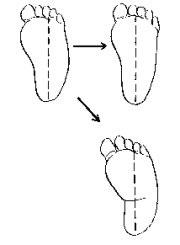Metatarsus
Adductus
Synopsis
Metatarsus adductus (MTA) or varus is
a condition that is commonly seen in newborns and young infants, where the
forefoot is twisted inwards relative to the hindfoot (or heel). Metatarsus
adductus and Metatarsus varus are terms used interchangeably, and some doctors
call the condition Metatarsus adductovarus. Some purists argue that there are
subtle differences, but most doctors from a practical standpoint cannot and do
not find a need to distinguish between them clinically. In
MTA, the forefoot is turned inwards, while the hindfoot (or heel) is normal. If
the hindfoot is involved, it becomes a more serious problem. If the forefoot
adductus or varus is associated with hindfoot valgus, it is called a skewfoot.
If the forefoot adductus is associated with hindfoot varus and ankle equinus
where the foot points downwards, the problem is a clubfoot.
MTA is very common in the newborn, and
is usually due to the feet being "packed" in the womb in that
position. The forefoot adduction at this stage is very flexible, and with
freedom of movement, this postural condition of MTA often improves over the next
6 to 12 weeks.
In about 15% of cases, the adducted
position of the forefoot does not improve. In fact, the deformity becomes less
flexible. A crease starts to appear on the medial border of the foot and a bony
"bump" on the lateral border of the foot, right at the junction of the
forefoot and hindfoot. This is the classic MTA that may require treatment.
|

|
|
The
picture above shows slight adductus at birth which usually corrects
spontaneously after 2 to 3 months (indicated by horizontal arrow). In
some cases, instead of correcting, it persists or gets worse, forming
the typical deformity of metatarsus adductus (indicated by downward
arrow). |
Diagnosis and Treatment
MTA that is diagnosed at birth does
not require treatment. It is usually postural, and with growth, the MTA resolves
spontaneously over a period of 6 to 12 weeks. If the forefoot adductus is
severe, your doctor may prescribe stretching exercises which he will teach you
to perform at home on the baby. X-rays are usually not necessary, unless the
doctor suspects something else.
After about 3 to 4 months of
observation and stretching exercises, if the forefoot adductus does not improve,
treatment may be necessary. The treatment options are as follows:
- Corrective shoes (outflare shoes)
are appropriate for the very mild and flexible cases only. They are not
often used at this time because, if the forefoot adductus is very mild and
very flexible, why treat it?
- Serial castings are reserved for
the very severe and rigid cases, and consists of castings every one or two
weeks until correction is obtained (which is usually 3 to 4 sets of casts),
followed by corrective shoes to hold the correction for about 3 months. This
is very time consuming, expensive and inconvenient for the baby and parent.
- More recently corrective bracing
has become very popular, because it addresses the problems associated with
castings. The doctor teaches the parent in the use of the brace, which
can be removed twice a day, if necessary. It is convenient, less expensive
than castings, and very effective. Correction is usually obtained in 4 to 6
weeks, after which the brace is used at night only for about 3 months to
hold the correction.
As stated above, without treatment,
85% of MTA’s resolve spontaneously. There remains 15% that requires treatment.
Your doctor will decide with you in terms of the timing and mode of correction,
whether by corrective casting or bracing. Once correction has been obtained,
recurrence is unlikely.
